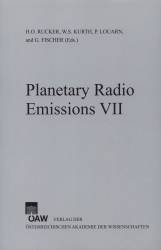
Planetary Radio Emissions VII, pp. 351-358, 2011/12/28
Proceedings of the 7th International Workshop on Planetary, Solar and Heliospheric Radio Emissions held at Graz, Austria, September 15–17, 2010

In this paper properties of decameter spikes observed in July - August, 2002 by radio telescope UTR-2 are discussed. These bursts have short duration (about 1s) and narrow frequency bandwidth (50 - 70 kHz). They are situated chaotically on the dynamic spectrum at the decameter wavelengths. These bursts are weak, their fluxes are not higher than 200 - 300 s.f.u. One of the interesting features of decameter spikes is linear dependence of frequency bandwidth on frequency. Such dependence can be explained in the frame of plasma mechanism of radio emission if to take into account that Langmuir waves are generated into the angle about 20 deg along the direction of electron beam propagation. In the paper the cause of small duration of spikes and generation of plasma waves in limited spatial regions are discussed.